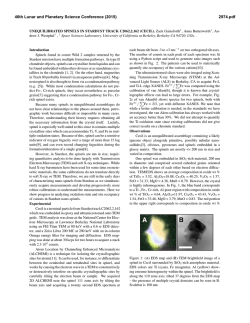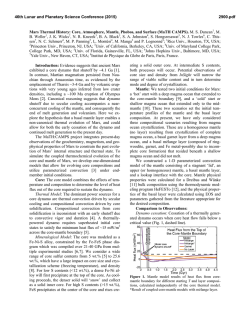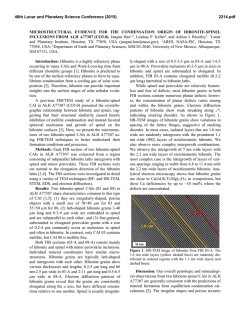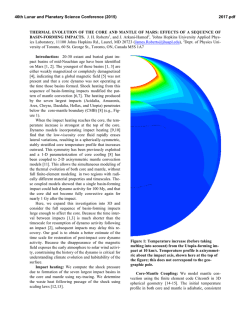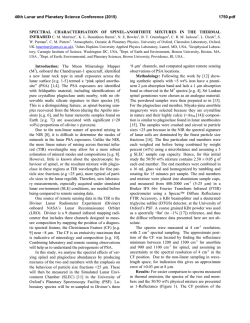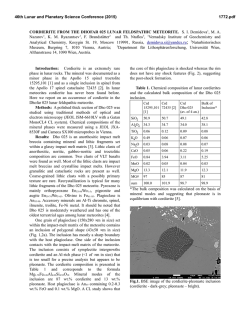
Natural evidence for garnet-spinel transition (GST) in the
Natural evidence for garnet-spinel transition (GST) in the Earth’s mantle BenXun Su ∗ Institute of Geology and Geophysics, Chinese Academy of Sciences, Beijing, 100029, China Abstract This study based on compiled world-wide garnet peridotite data confirms the GST in high P and T conditions, which was obtained from Al-free experimental system (MgO-Cr2O3-SiO2) by Klemme (2004). A new spinel-phase peridotite zone, garnet peridotite discontinuous zone, is defined, and another GST, although no experimental data, is principally and presumably proposed to exist. The garnet inclusion-bearing spinel harzburgite from Lashaine (Tanzania) provides the first evidence for the existence of ultra-high spinel zone and is explained as recrystallized minerals hosting the interacted residue of ancient oceanic lithosphere subducted into the great depth of more than 220km. These previously unexpected findings are generating great challenges to phase transition in extreme conditions and to our understanding of layered-structure of the Earth. In addition, coexistent five-phase peridotite is suggested to be naturally useful tool to constrain the GST. Keywords coexistent five-phase peridotite, garnet peridotite, garnet-spinel transition, ultra-high P-T, lithospheric mantle It is well-known that a series of discontinuities divide the Earth’s interior into three main parts, crust, mantle and core, which contain some sub-parts. The lithospheric mantle contact with the shallowest solid part, crust, and the shallowest sub-solid part, asthenosphere, at the top and the bottom, respectively, plays an important role in the long-term evolution of the earth. The crust-mantle boundary and lithosphere-asthenosphere boundary are recognizable seismically and rheologically (e.g., Pavlenkova, 1997; Chen et al., 2006), but the garnet-spinel transition (GST) in the mantle is geophysically invisible and not-well detected by geochemical approaches. However, the GST is important, because it is one of major phase boundaries in the Earth’s upper mantle and a key boundary to characterize global chemical and thermal heterogeneity in the lithospheric mantle and to constrain global chemical evolution of lithosphere in the Earth’s history (Green and Ringwood, 1967; Hales, 1969; O’Neill, 1981; Asimov et al., 1995; Klemme and O’Neill, 2000). For example, GST is of particular petrogenetic relevance as the interpretation of magmatic processes at mid-ocean ridges, and some geochemists have argued for beginning of melting just within the ∗ Corresponding author, e-mail: [email protected]; Phone: +86-10-82998514; address: P.O. Box 9825, Beijing 100029, China. 1 stability field of garnet lherzolite (e.g., Salters and Hart, 1989; LaTourette et al., 1993; Klemme, 2004), Two contrasting peridotites as mantle xenoliths hosted in volcanic rocks, garnet and spinel peridotites are available and high-pressure experiments of the garnet-spinel transition (e.g., Robinson and Wood, 1998; Klemme, 2004) is seated at ca. 2.8 GPa (= 85 km depth), while trace element and isotopic compositions of basaltic melt also suggest some differences between them (e.g., Salter, 1996; Schiano et al., 2000; Sen et al., 2005). Recent studies suggest coexistent five-phases (Grt-Sp-Cpx-Opx-Ol) peridotites are likely to constrain the GST because high-pressure experiment shows a wide range of the P-T stability where the garnet and spinel can coexist in peridotite and the garnet-spinel field strongly depends on the Cr/(Cr+Al) in the system (Fan et al., 1997; Klemme, 2004; Su et al., 2007). In the depth of 40-90km of some oceanic lithospheres, the increase and discontinuity of seismic waves were detected and suggested the phase transition zone (Shimamura and Asada, 1976). But many geochemists debated this suggestion. Carrol Webb and Wood (1986) suggested the depth and thickness of GST are about 40-55km and 6km, respectively. The GST beneath Australian continent is seated at the depth of 55-62km based on the study of Griffin and O’Reilly (1987). Xu et al. (1995) and Fan et al. (1997)’s studies revealed 55-70km maybe the location of the GST beneath eastern China. The problem is that the above geochemical studies are all based on the compiled spinel-phase and garnet-phase peridotites constraining the top and bottom boundary of GST, respectively. But it cannot give a convictive result because spinel-phase and garnet-phase peridotites are not directly from GST and moreover compiled samples are finite. Therefore, it is very imperious to seek an effective way to constrain GST. Experimental results of GST The phase-transition study is generally carried out using mostly composed composition and rarely natural sample. The position of GST is well understood in simplified chemical systems (e.g. CaO-MgO-Al2O3-SiO2) by experiments (MacGregor, 1965; Green and Ringwood, 1967; Hales, 1969; O’Hara et al., 1971; O’Neill, 1981; Gasparik and Newton, 1984; Robinson and Wood, 1998; Klemme and O’Neill, 2000). The results are compiled in Fig. 1. There is general agreement, although some shift, that these simple systems the GST is univariant and has a positive slope in pressure-temperature space. The noticeable point is that these experimental runs are based on fertile compositions, Al- and Ca-rich systems, which certainly yield the results fertile, basically shallow, part of the mantle. However, many studies on natural samples have proved these results, especially the popular-used and accepted GST line obtained by Klemme and O’Neill (2000). Klemme (2004) tried refractory compositions at high pressures and high temperatures to determine GST within depleted mantle. The GST in his Al-free system (MgO-Cr2O3-SiO2) exhibits a 2 negative slope in pressure-temperature space which is in stark contrast to that in a Cr-free or fertile compositions (Fig. 1). This may be related to the mantle composition at different depth. It has been known that the deeper continental mantle is clearly depleted in Al and more or less constant in Cr compared with normal fertile mantle, which is believed to be caused by melting events (e.g., Falloon and Green, 1988; Walter et al., 2002). In addition, the mantle shows increasing Cr/Cr+Al with depth as extremely Cr-rich garnets are commonly found in diamond and Cr/Cr+Al ratio of spinel increases with depth (e.g., Stachel and Harris, 1997; Stachel et al., 1998, 2000; Su et al., 2007). In spite of the GST at high pressure and temperature having been determined for several years, some problems are still unsolved, (1) no evidence from natural sample is found, (2) another spinel phase zone unexpected previously must exist somewhere between the MCrS and CMAS lines, (3) if so, what’s the formation of spinel in this condition, (4) why no any magma samples it, or transit garnet or other phase during descending. Coexistent five-phase peridotite (CFPP) In the section of the earth from crust to core, GST of lithospheric mantle is just a tiny boundary line because its thickness is assumed to be about 5-15km (e.g., Carrol Webb and Wood, 1986; Griffin and O’Reilly, 1987; Su et al., 2007). On the other hand, if magnified in a small scale, this boundary line can be considered as a zone because in which garnet/spinel transits into spinel/garnet gradually and continuously. Therefore, garnet and spinel coexist in the GST and this type of peridotite making up the GST zone can be name ‘coexistent five-phase peridotite (CFPP)’ which is composed of olivine, orthopyroxene, clinopyroxene, garnet and spinel. Of course, this definition is not exactly the ‘coexistent’ because it is difficult to reach compositional equilibration between minerals in the phase transit boundary. Although CFPP samples have been found in many locations (see references in Su et al., 2007), in my recent study, an extremely particular sample from Lashaine (Tanzania) reveals new knowledge about CFPP. This sample should be classified as spinel harzburgite based on its components (Fig. 2A). Just within one coarse spinel grain, a round-shaped garnet grain occurs as inclusions and displays sharp boundary with its host spinel (Fig. 2B). One orthopyroxene grain is also included in spinel (Fig. 2C) and low-Cr spinel inclusion presents within orthopyroxene (Fig. 2D). Mineral compositions in Table 1 show high Mg# and Cr#. This refractory feature is more or less consistent with the start composition in Klemme’s experiment (2004). CFPP xenoliths are direct samples from the GST. According to spinel-garnet relationship, these CFPP xenoliths can be divided into three types, spinel-zone, garnet-spinel transitional zone and garnet-zone peridotites, corresponding to upper, middle and bottom limits. Therefore, the depth and thickness of phase transition zone of lithospheric mantle can be determined through mineral composition of peridotite xenoliths and estimated T and P conditions. The features and compositional characteristics of CFPP were described in detail in Su et al. (2007) where provided an 3 excellent case, filling the gap of geotherm and constraining the GST beneath eastern China. Natural evidence for GST In my recent study, 231 garnet peridotite xenoliths from craton (134) and off-craton (97) and 198 orogenic garnet peridotites are compiled from 138 literatures including more than 120 localities (see detail in Su, submitted). All the estimated pressures and temperatures are plotted in Fig. 3. Overall, cratonic garnet peridotite xenoliths distribute near or below the cratonic geothermal line obtained from the mantle xenoliths entrained in South African kimberlites (Menzies and Chazot, 1995). Off-cratonic xenoliths are plotted within the area between oceanic geotherm and garnet-spinel transition line. The distribution of orogenic garnet peridotites indicates their low-temperature feature (Fig. 3). The noticeable point is that very few data are close to oceanic geotherm because lack of collected oceanic garnet peridotite data. The GST from CAMS system works well and restricts the upmost limit of garnet peridotites, especially in the field of pressure (1.5-2GPa) and temperature (800-1250 ºC). At great depth (6-10GPa), there is a garnet peridotite discontinuity can be deciphered excluding tow orogenic garnet peridotites. The top and bottom limits of the discontinuous zone are illustrated by dashed and bold lines, respectively (Fig. 3). Fortunately, the bottom limit excellently matches/overlaps the GST line in MCrS system (Klemme, 2004). This coincidence should be expected like the GST obtained in CAMS system and provide the natural evidence for experimental result in the first time. As mentioned above, the garnet peridotite discontinuous zone is deservedly corresponding to spinel peridotite field. Meanwhile, the dashed line is most likely to represent another expected GST between MCrS and CAMS system. This new GST hasn’t been understood because previous experiments are never done in the Al- and Cr-bearing system. On the other hand, if Cr added into CAMS, the system will be complex and beyond our ability to get multi-dimension phase diagram. This problem could be avoidable if Al is joined into MCrS system which is feasible to run in different proportions of Al, although taking quite long time. Klemme (2004)’s experiment of Al-free (MCrS) system revealed a possibility that spinel peridotite might exist at great depth (Fig. 1), and this study provides further constraint on the inference. However, there is no geological evidence from the nature reported so far. In the Lashaine garnet inclusion-bearing spinel harzburgite, the garnet and orthopyroxenes included in spinels are perhaps mineral assemblage formed at the same stage and their pressure and temperature yield 2.8GPa and 1059ºC, poltting on the oceanic geotherm. The mineral assemblages of olivine, orthopyroxene, clinopyroxene and spinel give high temperature of 1288ºC on average and ultra-high pressure of 7.2GPa, falling within the spinel-phase (MCrS) field. Taking into account the geological evolution of Lashaine, a subduction towards Tanzanian craton took place at ca. 2Ga (Moller et al., 1995). Garnet-orthopyroxene assemblage, possibly representing the ancient oceanic lithospheric 4 mantle, subducted to the great depth of 220km and was sequestered there for a very long period. During the stay, the interaction was necessarily happening and recrystallization of new mineral especially spinel would be proceeding simultaneously because of the condition just in the spinel-phase (MCrS) field. Therefore, it is easily understandable that garnet and orthopyroxene inclusions, the reaction residue, are rich in Cr and still reserve Al- and Ca- enriched features (Table 1), and that spinel inclusion and its host orthopyroxene display reaction feature (Fig. 2D). Another possible explanation is on the contrary, that is both inclusions generated from exsolution of spinel harzburgite related to the decompression process due to the East Afrian Rift. But the round shape and the sharp boundary between inclusion and host spinel are not support the latter inference. Considering no comparable case from other locality, the author’s explanation needs to get more evidence from other aspects, for instance, phase-transit experiment mentioned above and trying to find more inclusions. Summary 1) This study provides natural evidence for two GSTs obtained by previous experiments and deciphers another one and one anticipated ultra-high pressure and temperature spinel-phase zone. Three GSTs, defined as GST1, GST2 and GST3, reconstructs the layered structure of the mantle illustrated in Fig. 4. This interesting finding triggers us to re-estimate the structure of the earth and mineral-phase experiment. 2) CFPP should be assumed as the naturally precise tool to determine the GST. 3) The garnet inclusion-bearing spinel harzburgite from Lashaine (Tanzania) gives us the new understanding of garnet-spinel coexistent relationship and provides the first evidence for the existence of ultra-high pressure spinel. Its formation can be explained as recrystallized minerals hosting the interacted residue of ancient oceanic lithosphere subducted into the great depth just within the field between GST2 and GST3. Reference Asimov PD, Hirschmann MM, Ghiorso MS, O’Hara MJ and Stolper EM. 1995. The effect of pressure induced solid-solid phase transitions on decompression melting of the mantle. Geochim. Cosmochim. Acta, 59, 4489-4506 Brey GP and Kohler T. 1990. Geothermobarometry in four-phase lherzolites II, new thermobarometers and pratical assessment of existing thermobarmeters. J. Petrol. 31, 1353-1378 Carroll Webb SA and Wood BJ. 1986. Spinel-pyroxene-garnet relationship and their dependence on Cr/Al ratio. Contrib. Mineral. Petrol. 77, 185-194 Chen L, Zheng TY and Xu WW. 2006. A thinned lithospheric image of the Tanlu Fault Zone, eastern China: Constructed from wave equation based receiver function migration. Journal of 5 Geophysical Research 111, 1-15 Falloon TJ and Green DH. 1988. Anhydrous partial melting of peridotite from 8 to 35 kb and the petrogenesis of MORB. J. Petrol. 379-414 (Special Lithosphere Issue) Fan QC, Liu RX, Xie HS, Zhang YM, Xu P and Lin ZR. 1997. Experimental study of spinel-garnet phase transition in upper mantle and its significance. Science in China (D) 27, 109-114 Gasparik T and Newton RC. 1984. The reversed alumina contents of orthopyroxene in equilibrium with spinel and forsterite in the system MgO-Al2O3-SiO2. Contrib. Mineral. Petrol. 85, 186-196 Green DH and Ringwood AE. 1967. The stability field of aluminous pyroxene peridotite and garnet peridotite and their relevance in upper mantle structure. Earth Planet. Sci. Lett. 3, 151-160 Griffin WL and O’Reilly SY. 1987. Is the continental Moho the crust-mantle boundary? Geology 15, 241-244 Hales AL. 1969. A seismic discontinuity in the lithosphere. Earth Planet. Sci. Lett. 7, 44-46 Klemme S. 2004. The influence of Cr on the garnet-spinel transition in the Earth’s mantle: experiments in the system MgO-Cr2O3-SiO2 and thermodynamic modeling. Lithos 77, 639-646 Klemme S and O’Neill HSC. 2000. The effect of Cr on the solubility of Al in orthopyroxene: experiments and thermodynamic modelling. Contrib. Mineral. Petrol. 140, 84-98 Kohler TP and Brey GP. 1990. Calcium exchange between olivine and clinopyroxene calibrated as a geobarometer for natural peridotites from 2 to 60 kbar with applications. Geochim. Cosmochim. Acta 54, 2375-2388 LaTourette TK, Kennedy AK and Wasserburg GJ. 1993. Thorium-uranium fractionation by garnet: evidence for a deep source and rapid rise of oceanic basalts. Science 261, 739-742 MacGregor ID. 1965. Stability fields of spinel and garnet peridotites in the synthetic system MgO-CaO-Al2O3-SiO2. Year b.-Carnegie Inst. Wash. 64, 126-134 Menzies MA and Chazot G. 1995. Fluid processes in diamond to spinel facies shallow mantle. Journal of Geodynamics 20, 387-415 Moller A, Appel P, Mezger K and Schenk V. 1995. Evidence for a 2 Ga subduction zone: eclogites in the Usagara belt of Tanzania. Geology 23, 1067-1070 O’Hara MJ, Richardson SW and Wilson G. 1971. Garnet-peridotite stability and occurrence in crust and mantle. Contrib. Mineral. Petrol. 32, 48-68 O’Neill HSC. 1981. The transition between spinel lherzolite and garnet lherzolite, and its use as a geobarometer. Contrib. Mineral. Petrol. 77, 185-194 Pavlenkova NI. 1997. General features of the upper mantle structure from seismic data. In: Fuchs K. (ed). Upper mantle heterogeneities from active and passive seismology, Kluwer Academic Publishing, Netherlands, 225-236 Robinson JAC and Wood BJ. 1998. The depth of the garnet/spinel transition in fractionally melting peridotite. Earth Planet. Sci. Lett. 164, 277-284 6 Salters VJM and Hart SR. 1989. The hafnium paradox and the role of garnet in the source of mid-ocean-ridge basalts. Nature 342, 420-422 Salters VJM. 1996. The generation of mid-ocean ridge basalts from the Hf and Nd isotope perspective. Earth Planet. Sci. Lett. 141, 109-123 Schiano P, Eiler JM, Hutcheon ID and Stolper EM. 2000. Primitive CaO-rich, silica-undersaturated melts in island arcs: evidence for the involvement of clinopyroxene-rich lithologies in the petrogenesis of arc magmas. Geochemistry, Geophysic, Geosystems, 1999GC000032 Sen G, Keshav S and Bizimis M. 2005. Hawaiian lithosphere and magmas: composition and thermal characteristics of the lithosphere beneath Oahu: insights from mantle xenoliths. American Mineralogist, 90, 871-887 Shimamura H and Asada T. 1976. Apparent velocity measurements on oceanic lithosphere. Physics of the Earth and Planetary Interiors, 13, 15-22 Stachel T and Harris JW. 1997. Syngenetic inclusions in diamond from the Birim field (Ghana)-a deep peridotitic profile with a history of depletion and re-enrichment. Contrib. Mineral. Petrol. 127, 336-352 Stachel T, Viljoen KS, Brey GP, Harris JW. 1998. Metasomatic processes in herzolitic and harzburgitic domains of diamondiferous lithospheric mantle-REE in garnets from xenoliths and inclusions in diamonds. Earth Planet. Sci. Lett. 159, 1-12 Stachel T, Harris JW, Brey GP and Joswig W. 2000. Kankan diamonds (Guinea): II. Lower mantle inclusion parageneses. Contrib. Mineral. Petrol. 140, 16-27 Sachtleben TH and Seck HA. 1981. Chemical control of Al-solubility in orthopyroxene and its implications on pyroxene geothermometry. Contrib. Mineral. Petrol. 78, 157-165 Su BX, Zhang HF, Wang, QY, Sun H, Xiao Y and Ying JF. 2007. Spinel-garnet phase transition zone of Cenozoic lithospheric mantle beneath the eastern China and western Qiling and its T-P condition. Acta Petrologica Sinica 23, 1313-1320 (in Chinese with English abstract) Su BX. 2008. Petrologic records of deep lithospheric mantle: A review of world-wide garnet peridotites. (submitted) Walter M, Katsura T, Kubo A, Shinmei T, Nishikawa O, Ito E, Lesher C and Funakoshi K. 2002. Spinel-garnet lherzolite transition in the system CaO-MgO-Al2O3-SiO2 revisited: an in situ X-ray study. Geochim. Cosmochim. Acta 66, 2109-2121 Wells PRA. 1977. Pyroxene thermometry in simple and complex systems. Contrib. Mineral. Petrol. 62, 129-139 Witt GE and Seck HA. 1991. Solubility of Ca and Al in orthopyroxene from spinel peridotite: An improved version version of an emoirical geothermometer. Contrib. Mineral. Petrol. 106, 431-439 Wood BJ and Banno S. 1973. Garnet-orthopyroxene relationships in simple and complex systems. 7 Contrib. Mineral. Petrol. 42, 109-124 Xu YG, Lin CY, Shi LB, Mercier JCC and Ross JV. 1995. Upper mantle geotherm for eastern China and its geological implications. Science in China (B) 38, 1482-1492 Figure Caption Fig. 1 A compilation of experimental data on the garnet-spinel transition in the Earth’s mantle. GN, Gasparik and Newton (1984), KO, Klemme and O’Neill (2000), and W, Walter et al. (2002) based on the Cr-free system CaO-MgO-Al2O3-SiO2 (CMAS); RW, Robinson and Wood (1998), based on the natural sample; K, Klemme (2004), based on the Al-free system (MCrS: MgO-Cr2O3-SiO2); Cratonic geotherm from Menzies and Chazot (1995). Fig. 2 Petrographic features of spinel harzburgite from Lashaine (Tanzania). A, mineral assemblage of olivine, orthopyroxene and spinel hosting garnet inclusion; B, garnet inclusion in spinel showing sharp boundary without reaction texture; C, orthopyroxene inclusion in spinel; D, low-Cr spinel inclusion within orthopyroxene. Fig. 3 Pressure and temperature plot of global 231 garnet peridotite xenoliths from craton (134, open cycle) and off-craton (97, open triangle) and 198 orogenic garnet peridotites (cross) collected from 138 literatures including more than 120 localities (see detail in Su, submitted). Oceanic and cratonic geotherms are from Menzies and Chazot (1995); Garnet-spinel transition line (CMAS) is from Klemme and O’Neill (2000); Garnet peridotite discontinuous zone shown as spinel (MCrS) is defined by dashed and bold lines drawn in this study based on the data distribution; Open square, estimated by mineral assemblage of olivine, orthopyroxene, clinopyroxene and spinel; Filled square, estimated by garnet-orthopyroxene inclusions. Fig. 4 Three GSTs’ position and depth in the layered-structure of the Earth’s mantle. 8
© Copyright 2026

